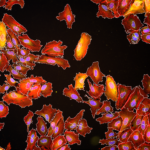Lien vers Pubmed [PMID] – 18624796
Cell. Microbiol. 2008 Nov;10(11):2208-22
Listeria monocytogenes surface proteins internalin (Inl)A and InlB interact with the junctional protein E-cadherin and the hepatocyte growth factor (HGF) receptor Met, respectively, on the surface of epithelial cells to mediate bacterial entry. Here we show that InlA triggers two successive E-cadherin post-translational modifications, i.e. the Src-mediated tyrosine phosphorylation of E-cadherin followed by its ubiquitination by the ubiquitin-ligase Hakai. E-cadherin ubiquitination induces the recruitment of clathrin that is required for optimal bacterial internalization. We also show that the initial clustering of E-cadherin at the bacterial entry site requires caveolin, a protein normally involved in clathrin-independent endocytosis. Strikingly clathrin and caveolin are also recruited at the site of entry of E-cadherin-coated sepharose beads and functional experiments demonstrate that these two proteins are required for bead entry. Together these results not only document how the endocytosis machinery is recruited and involved in the internalization of a zippering bacterium, but also strongly suggest a functional link between E-cadherin endocytosis and the formation of adherens junctions in epithelial cells.



